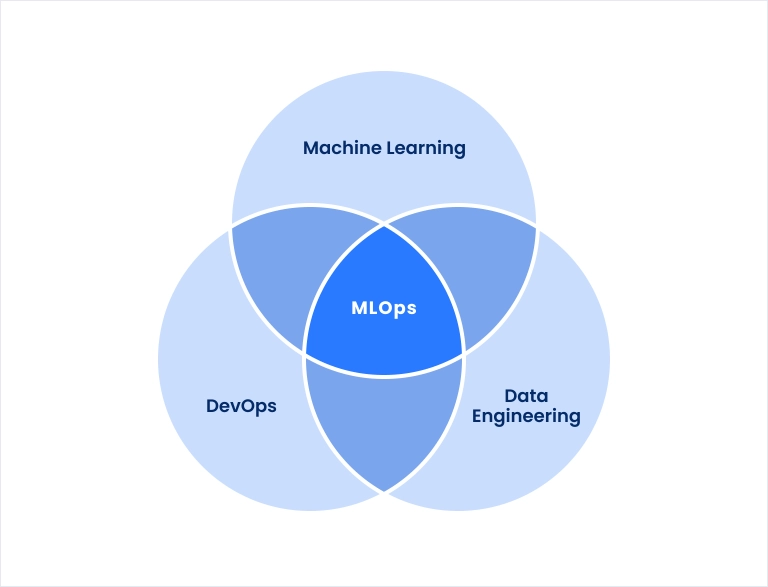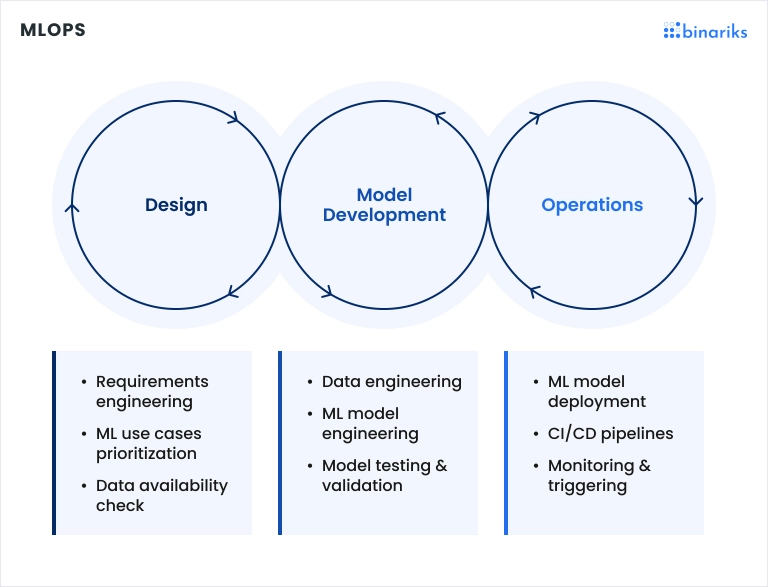MLOps and data engineering are sometimes viewed as separate tools within the AI domain, each with defined roles. However, their interaction is characterized by collaboration rather than competition.
While MLOps focuses on operationalizing and managing machine learning models, data engineering involves collecting, processing, and preparing data for analysis. Together, they form a cohesive framework for the development and deployment of machine learning systems, significantly improving efficiency and reliability in data science and AI workflows.
This article delves beyond the misconceptions to explore the powerful synergy between these two fields. We'll learn the difference between MLOps and data engineers and then dive into the surprising number of areas where their skills overlap.
We'll also explore real-world use cases that showcase how these disciplines collaborate to streamline development, ensure smooth deployment, and ultimately unleash the true potential of AI.
MLOps vs. data engineer

There is a fairly widespread opinion that MLOps is mostly data engineering. While both MLOps engineers and data engineers play vital roles in bringing AI projects to life, their areas of expertise differ. Here's a breakdown of MLOps vs. data engineer work styles and how they interweave within a project.
Focus area
MLOps engineer: Concerned with the entire lifecycle of a machine learning model, from development and training to deployment, monitoring, and maintenance. They are the bridge between the data science world and the real world, ensuring models perform optimally in production.
Data engineer: They are architects of the data infrastructure. They build the pipelines that ingest, clean, store, and prepare the data that fuels machine learning models. Essentially, they provide the high-quality data that MLOps engineers need to train and run effective models.
Responsibilities
MLOps engineer:
- Version control and model management;
- Building and automating deployment pipelines;
- Monitoring model performance and drift;
- A/B testing and continuous optimization.
Data engineer:
- Designing data pipelines and warehouses;
- Data cleaning and transformation;
- Ensuring data security and governance;
- Collaborating with data scientists on data exploration.
Working together on a project
Let's use a simple example to better explain MLOps vs data engineering. Imagine you've built a fantastic new machine learning model to predict customer churn. The data engineer has constructed the pipelines to feed your model clean, up-to-date customer data. The MLOps engineer then takes over, deploying the model to a production environment and monitoring its performance. They'll also be on hand to make adjustments and ensure the model delivers accurate predictions as customer data evolves.
In essence, MLOps with data engineering work hand-in-hand, each playing a crucial role in bringing machine learning models from the drawing board to real-world impact.
Which scenarios can be the same?

You can Google "Is MLOps data engineering?" and find various backed answers and opinions. The truth is, as the folks at MLOps Community point out, that there's a significant overlap between the two, especially in the early stages of the machine learning lifecycle.
The core responsibilities of a data engineer – building data pipelines, ensuring data quality, and managing data infrastructure – are absolutely essential for training machine learning models. In fact, for smaller projects or startups just getting their feet wet with AI, a skilled data engineer might be able to handle many of the tasks that would typically fall under the MLOps umbrella.
Here's where the lines start to blur:
- Data pipeline development: Both data engineers and MLOps engineers are comfortable building and managing data pipelines. The critical difference lies in the specifics. Data engineers might focus on pipelines that feed various analytical tasks, while MLOps engineers tailor pipelines specifically for model training and evaluation.
- Version control: Tracking changes to data and models is crucial. Both data engineers and MLOps engineers can leverage version control systems to ensure they're working with the correct versions of data and models throughout the development process.
However, as projects grow in complexity and the need for robust model management becomes paramount, the specific skillset of an MLOps engineer becomes invaluable. Understanding the role of MLOps data engineering is crucial for areas like:
- Model deployment and monitoring: Ensuring models run smoothly in production environments requires the specialized tools and expertise of MLOps engineers.
- A/B testing and model experimentation: Comparing different models and optimizing performance is a core function of MLOps engineers.
- MLOps tools and frameworks: There's a growing ecosystem of MLOps tools for tasks like model versioning, automated deployment, and performance monitoring. MLOps engineers are proficient in using these tools to streamline the machine learning lifecycle.
Data engineering lays the foundation for successful machine learning projects, while MLOps engineers ensure those projects reach their full potential in the real world. While there's overlap in the early stages, the skillsets diverge as projects mature and the need for specialized MLOps expertise grows.
Unlock your data's potential: discover Binariks' Big Data and analytics services today!
Use cases of MLOps and data engineering
Now that we've untangled the relationship between MLOps and data engineering, let's jump into some compelling real-world use cases.
Customizable reporting and centralizing data (healthcare)
Today, with the help of business intelligence, healthcare professionals can access customizable reports with daily updates. This allows them to track essential metrics such as the average cost of medical services, real inflation rates, and seasonal fluctuations in morbidity.
Moreover, centralizing medical history in one accessible place has become increasingly important. By consolidating medical records in data repositories, healthcare providers can efficiently access patient histories, aiding in better treatment planning and management. This centralized approach also enables the identification of repeated patterns or stamps for the same diseases, facilitating early diagnosis and personalized patient care.
Of course, BI solutions are not limited to healthcare. There is a general trend towards implementing solutions like PowerBI, training managers to use them, unloading IT in terms of uploads, and analysts in terms of preparing the same type of reports regularly. Accordingly, a separate area in IT is emerging — the creation of repositories where data will be downloaded from various systems, processed as needed, and provided to BI solution users for further processing.
Recommendation engine optimization (E-commerce)
Imagine a recommendation engine for an online store. Data engineers would build pipelines to continuously feed the model with fresh customer data and product information.
MLOps engineers, in turn, would ensure the smooth deployment of the model, monitor its performance in recommending relevant products, and potentially implement A/B testing to compare different recommendation algorithms. This teamwork optimizes the engine, leading to happier customers and increased sales.
Fraud detection (banking)
Financial institutions leverage machine learning to detect fraudulent transactions . In this scenario, data engineers would build pipelines that ingest real-time transaction data and historical customer information.
MLOps engineers would then deploy the fraud detection model, monitor its accuracy in identifying suspicious activity, and continuously fine-tune the model as fraudsters develop new tactics. This collaboration safeguards financial systems and protects customer accounts.
Predictive maintenance (manufacturing)
Many factories have sensors for machinery health monitoring. Data engineers can develop pipelines to collect sensor data and feed it into a machine learning model for anomaly detection.
So, MLOps engineers would deploy the model, monitor its performance in predicting equipment failures, and trigger maintenance alerts to prevent costly downtime. This teamwork ensures smooth operations and maximizes production efficiency.
Traffic prediction (smart cities)
Today's smart cities can leverage machine learning to predict traffic congestion. Data engineers would build pipelines to collect real-time traffic data from sensors and historical information. MLOps engineers would then deploy the model to edge devices or the cloud, ensuring it can handle the high volume of incoming data.
They can also monitor the model's performance in predicting traffic flow and potentially integrate it with traffic management systems to optimize traffic light patterns. This collaboration helps reduce congestion, improve commutes, and create a smarter city experience.
Cybersecurity
Organizations use machine learning to identify and block cyberattacks in real time. Data engineers build pipelines to ingest network traffic data and security logs. MLOps engineers deploy the model at scale, ensuring it can process massive amounts of data quickly. Besides, they also monitor the model's accuracy in detecting threats and trigger alerts for potential security incidents. This teamwork strengthens an organization's cybersecurity posture and safeguards its critical data.
These are just a few examples. The true value of MLOps with data engineering working together lies in their ability to unlock the potential of machine learning across various industries. With a robust data foundation, smooth model deployment, and continuous monitoring, this dynamic duo can create AI-driven innovations that benefit not only businesses but society as a whole.
Deployment and serving of models
We've explored the synergy between MLOps and data engineering throughout the machine learning lifecycle. But the real magic happens when the model takes center stage and delivers its predictions in the real world. This is where deployment and serving, orchestrated by MLOps engineers, come into play.
MLOps engineers ensure the model is packaged correctly for the target environment (cloud, on-premise server, etc.) and deployed seamlessly. This involves tasks like:
- Containerization: MLOps engineers often leverage containerization technologies like Docker to package the model, its dependencies, and runtime environment into a portable unit. This ensures the model runs consistently regardless of the underlying infrastructure.
- Model serving frameworks: Frameworks like TensorFlow Serving or Kubeflow facilitate smooth model serving. These frameworks handle tasks like model loading, request routing, and scaling to meet prediction demands.
Once deployed, serving is like keeping the show running smoothly night after night. MLOps engineers monitor the model's performance in real time to ensure it continues to deliver accurate and timely predictions. This involves:
- Performance monitoring: MLOps engineers track key metrics like accuracy, latency (prediction time), and resource utilization. This helps identify potential issues like performance degradation or model drift (where the model's predictions become less accurate over time due to changes in the underlying data).
- A/B testing: MLOps engineers might conduct A/B testing by comparing different model versions to identify the best performer. This allows for continuous improvement and optimization of the model's effectiveness.
By skillfully managing deployment and serving, MLOps engineers ensure that machine learning models transition from experimentation to real-world impact.
They become the unseen heroes, working tirelessly behind the scenes to maintain the AI systems, enabling them to deliver valuable insights efficiently.
Lift your business to new heights with Binariks' AI, ML, and Data Science services
Final thoughts
MLOps and data engineering aren't rivals in some competition but rather collaborators. Data engineers build the foundation, and MLOps engineers ensure a flawless debut. Together, they orchestrate the entire machine learning lifecycle.
This potent collaboration unleashes the full potential of AI, translating abstract models into practical solutions that drive business growth. The bond between MLOps and data engineering will only strengthen as AI evolves, promising more innovative applications and advancements.
Share

